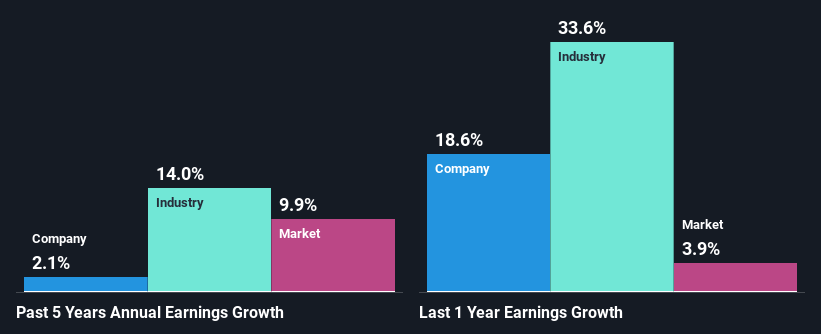Delignit AG's (ETR:DLX) Stock On An Uptrend: Could Fundamentals Be Driving The Momentum?
Most readers would already be aware that Delignit's (ETR:DLX) stock increased significantly by 14% over the past week. We wonder if and what role the company's financials play in that price change as a company's long-term fundamentals usually dictate market outcomes. Specifically, we decided to study Delignit's ROE in this article.
Return on Equity or ROE is a test of how effectively a company is growing its value and managing investors’ money. In other words, it is a profitability ratio which measures the rate of return on the capital provided by the company's shareholders.
Check out our latest analysis for Delignit
How Do You Calculate Return On Equity?
ROE can be calculated by using the formula:
Return on Equity = Net Profit (from continuing operations) ÷ Shareholders' Equity
So, based on the above formula, the ROE for Delignit is:
10% = €2.8m ÷ €27m (Based on the trailing twelve months to December 2022).
The 'return' is the yearly profit. So, this means that for every €1 of its shareholder's investments, the company generates a profit of €0.10.
Why Is ROE Important For Earnings Growth?
We have already established that ROE serves as an efficient profit-generating gauge for a company's future earnings. Depending on how much of these profits the company reinvests or "retains", and how effectively it does so, we are then able to assess a company’s earnings growth potential. Assuming everything else remains unchanged, the higher the ROE and profit retention, the higher the growth rate of a company compared to companies that don't necessarily bear these characteristics.
A Side By Side comparison of Delignit's Earnings Growth And 10% ROE
To start with, Delignit's ROE looks acceptable. Yet, the fact that the company's ROE is lower than the industry average of 20% does temper our expectations. Further, Delignit's five year net income growth of 2.1% is on the lower side. Not to forget, the company does have a decent ROE to begin with, just that it is lower than the industry average. Hence there might be some other aspects that are keeping growth in earnings low. For example, it could be that the company has a high payout ratio or the business has allocated capital poorly, for instance.
We then compared Delignit's net income growth with the industry and found that the company's growth figure is lower than the average industry growth rate of 15% in the same period, which is a bit concerning.
The basis for attaching value to a company is, to a great extent, tied to its earnings growth. The investor should try to establish if the expected growth or decline in earnings, whichever the case may be, is priced in. This then helps them determine if the stock is placed for a bright or bleak future. Is DLX fairly valued? This infographic on the company's intrinsic value has everything you need to know.
Is Delignit Using Its Retained Earnings Effectively?
Delignit's low three-year median payout ratio of 8.7% (or a retention ratio of 91%) should mean that the company is retaining most of its earnings to fuel its growth. This should be reflected in its earnings growth number, but that's not the case. Therefore, there might be some other reasons to explain the lack in that respect. For example, the business could be in decline.
Additionally, Delignit has paid dividends over a period of nine years, which means that the company's management is determined to pay dividends even if it means little to no earnings growth. Our latest analyst data shows that the future payout ratio of the company is expected to drop to 5.4% over the next three years. As a result, the expected drop in Delignit's payout ratio explains the anticipated rise in the company's future ROE to 13%, over the same period.
Conclusion
In total, it does look like Delignit has some positive aspects to its business. However, while the company does have a decent ROE and a high profit retention, its earnings growth number is quite disappointing. This suggests that there might be some external threat to the business, that's hampering growth. That being so, the latest analyst forecasts show that the company will continue to see an expansion in its earnings. To know more about the company's future earnings growth forecasts take a look at this free report on analyst forecasts for the company to find out more.
Have feedback on this article? Concerned about the content? Get in touch with us directly. Alternatively, email editorial-team (at) simplywallst.com.
This article by Simply Wall St is general in nature. We provide commentary based on historical data and analyst forecasts only using an unbiased methodology and our articles are not intended to be financial advice. It does not constitute a recommendation to buy or sell any stock, and does not take account of your objectives, or your financial situation. We aim to bring you long-term focused analysis driven by fundamental data. Note that our analysis may not factor in the latest price-sensitive company announcements or qualitative material. Simply Wall St has no position in any stocks mentioned.
Join A Paid User Research Session
You’ll receive a US$30 Amazon Gift card for 1 hour of your time while helping us build better investing tools for the individual investors like yourself. Sign up here

 Yahoo Finance
Yahoo Finance 
